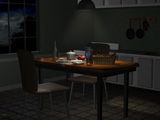

|
| Syllabus
|
| Project 04 | Digital Interior |
assignment
description image by Luo Xie |
Studying Color and
Textures and Transitions within a Space through Genre This project considers both objects and environment. You will be given a scene that includes a pre-determined space and pre-determined props, similar to the physical props you used in Project 3. All of the geometry is now associated with descriptive shaders. Shaders refer to materials, made up of colors and textures, that are applied to surfaces. In particular, we will focus on visually describing surfaces through lighting and developing a better understanding of how lighting effects shaders on surfaces. You and your partner(s) will choose contrasting genres. Each team member will design lighting for the space and props that is based one of the genre schemes. The lighting design should enhance, describe and inform the viewer on the genre. The images should vary in light quantity to address genre issues. The images should vary in light placements and types to address genre issues. By using descriptive shaders and lights, the image you create should expand the composition in mood and drama. Incorporate all of the lessons you learned when you executed the "physical" part of this project. |
| Requirements | Each chosen genre must be
researched, presented and represented by existing visual examples from
professional/commercial film or performance. On the project web page the research must be posted and the genre must be clearly identified through descriptive writing that answers the questions: what is the genre? how does the lighting describe the genre? what lights are used? how are the lights set? what special effects are used to enhance the genre? how is the camera (composition) used to communicate the genre? For your final product the group will render an animation that begins with one genre and transitions to the next. The transitions are just as important as the beginning and ending genre so they must have meaning within the context of the genre and storyline. Lighting changes must be choreographed through keyframe animation, i.e. a cross-dissolve in a image editing software is not acceptable. It is suggested that each group work from a master lighting plan, from which genres are established. Groups of 2 people are limited to a nine-second (270 frame) animation that begins with one genre and transitions, through animation, to the second genre. Groups of 3 people are limited to a fifteen-second (450 frame) animation. There must be a 3 second hold on each genre once it is fully established. Render at video resolution (640x480) using Maya. Document your digital lighting set up with screen shots of the top, front and side views. Label each light in the views. Post these images on your Project #4 web page with appropriate explanatory text. You may not move any props substitute any props change or add any shaders |
| grading criteria |
1. artistic effectiveness and expression of genre |
| documentation |
Project 4 should be documented
with: |
| readings | [digital] Lighting &
Rendering by Birn Chapter 6 - Color Chapter 8 - Composition and Staging Learning Maya: online manual - Shaders Kahrs, John, Sharon Calahan, Dave Carson, and Stephen Poster, A.S.C., "Pixel Cinematography: A Lighting Approach for Computer Graphics," ACM Siggraph Course Notes #30, 1996 |
| Syllabus
|
| Copyright 2001 Advanced Computing Center for the Arts and Design and the Department of Theatre The Ohio State University |